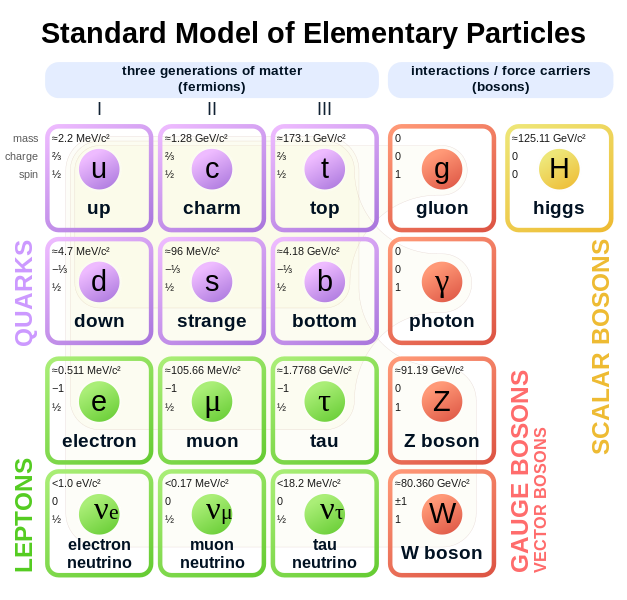CLASSIFICATION OF ELEMENTARY PARTICLES

Elementary particles are fundamental entities that are not composed of smaller constituents. They are the building blocks of matter and the universe, playing a crucial role in understanding the fundamental forces and structure of all matter and energy. These particles are considered elementary because they do not appear to have any substructure, meaning they cannot be further divided into smaller components.

FERMIONS:
Fermions are a category of fundamental particles that constitute matter and follow Fermi-Dirac statistics, characterized by the Pauli Exclusion Principle. They possess half-integer values of spin (e.g., 1/2, 3/2, etc.) and have essential roles in shaping the universe's structure and behavior.
Types of Fermions:
Quarks:
Quarks are elementary particles that experience the strong nuclear force and are constituents of composite particles called hadrons.
They come in six types or flavors:
- Up Quark (u): Carries a charge of +2/3e and is found in protons and neutrons.
- Down Quark (d): Carries a charge of -1/3e and is also present in protons and neutrons.
- Charm Quark (c): Heavier than up and down quarks, discovered in high-energy particle collisions.
- Strange Quark (s): Also heavier and found in certain exotic particles and cosmic rays.
- Top Quark (t): Extremely massive and unstable, discovered in 1995.
- Bottom Quark (b): Less massive than the top quark but still relatively heavy.
Quarks are never found in isolation due to confinement. They combine in groups of three to form baryons (e.g., protons, neutrons) or in quark-antiquark pairs to create mesons.
Baryons:
Baryons are a class of composite particles made up of three quarks. They belong to the broader category of hadrons, which also includes mesons. Baryons consist of three quarks held together by the strong nuclear force mediated by gluons, which are themselves carriers of the strong force.
Characteristics of Baryons:
- Quark Composition: Baryons are composed of three quarks, which can be of different flavors. The most common baryons are:
- Protons: Consist of two up quarks and one down quark (uud).
- Neutrons: Comprise two down quarks and one up quark (udd).
- Other less common baryons exist with different quark combinations.
- Spin and Isospin: Baryons have half-integer values of spin (1/2, 3/2, etc.) due to their quark constituents. They also possess isospin, a quantum number analogous to spin but related to the symmetry between certain types of particles.
- Strong Interaction: Baryons experience the strong nuclear force, mediated by gluons. This force binds the quarks together within the baryon, confining them and preventing individual quarks from being observed in isolation (a phenomenon known as color confinement).
- Stability: Protons, being the lightest baryons, are considered stable and form the core of atomic nuclei. Neutrons are also stable within nuclei but undergo beta decay when isolated.

Role of Baryons:
- Nuclear Structure: Baryons like protons and neutrons are essential constituents of atomic nuclei. Protons carry a positive charge and neutrons carry no charge, contributing to the stability and structure of atoms.
- Cosmic Evolution: During the early universe, the abundance of protons and neutrons played a critical role in nucleosynthesis, the process by which light atomic nuclei formed in the first few minutes after the Big Bang.
- Particle Collisions: Baryons are produced and studied in high-energy particle colliders such as the Large Hadron Collider (LHC), where scientists explore their properties and interactions at extreme energies.
Nucleons:
Nucleons are a subgroup of baryons primarily found within atomic nuclei. The two most common nucleons are:
- Proton (p+): The proton is a stable baryon with a positive charge. It consists of two up quarks and one down quark (uud) and plays a central role in the structure of atomic nuclei, contributing to their stability and atomic number.
- Neutron (n0): Neutrons have no net charge and are also stable within atomic nuclei. They consist of two down quarks and one up quark (udd). Neutrons are crucial in stabilizing atomic nuclei, balancing the repulsion between positively charged protons.
Hyperons:
Hyperons are a subclass of baryons that contain at least one strange quark (s) among their constituent quarks, distinguishing them from nucleons. These particles exhibit properties that differ from those composed solely of up and down quarks. Some examples of hyperons include:
- Lambda (Λ): The lambda hyperon is stable and consists of one up quark, one down quark, and one strange quark (uds). It has a slightly longer lifetime than other hyperons and plays a role in weak interactions.
- Sigma (Σ): Sigma hyperons come in various types based on their quark composition. For instance:
- Sigma-plus (Σ+): Comprises two up quarks and one strange quark (uus).
- Sigma-zero (Σ0): Consists of one up quark, one down quark, and one strange quark (uds).
- Sigma-minus (Σ-): Composed of one down quark and two strange quarks (dss).
- Xi (Ξ): Xi hyperons have two strange quarks among their constituents:
- Xi-zero (Ξ0): Contains one up quark, one down quark, and two strange quarks (uds).
- Omega (Ω): The omega hyperon is composed of three strange quarks (sss). It has the highest strangeness content and is relatively massive compared to other hyperons.
Comparison:
- Nucleons (Protons and Neutrons): These are stable baryons found in atomic nuclei, crucial for defining atomic structure and stability.
- Hyperons: These baryons contain strange quarks and exhibit different decay patterns and lifetimes compared to nucleons. They are often involved in weak interactions and are important for understanding particle physics and the behavior of matter under extreme conditions.
Beyond Baryons:
Apart from baryons composed of three quarks, other exotic particles called pentaquarks (comprising four quarks and one antiquark) have been observed and studied in recent years, expanding our understanding of the strong force and the configurations particles can form.
Mesons:
Mesons are a type of composite particle composed of one quark and one antiquark bound together by the strong nuclear force. They belong to the hadron family, which also includes baryons (such as protons and neutrons). Mesons are unique in that they are made of one quark and one antiquark, unlike baryons that consist of three quarks.
Characteristics of Mesons:
- Quark-Antiquark Composition: Mesons are formed by a quark and an antiquark pair. For example:
- Pions (π± and π0): The most common mesons, consisting of an up quark paired with a down antiquark (π+) or a down quark paired with an up antiquark (π-) and a neutral version (π0).
- Kaons (K± and K0): Comprising a strange quark and an up or down antiquark.
- Other mesons exist with different quark-antiquark combinations.
- Spin and Lifetime: Mesons have integer or non-integer values of spin due to their quark-antiquark structure. Their lifetimes can vary from extremely short (fractions of a nanosecond) to relatively longer, depending on their specific characteristics.
- Strong Interaction: Like baryons, mesons experience the strong nuclear force mediated by gluons. This force holds the quark and antiquark together within the meson.
Role of Mesons:
- Strong Force Exploration: Mesons provide insights into the strong nuclear force and the behavior of quarks within composite particles. Studying mesons helps understand the interactions between quarks and antiquarks.
- Particle Colliders: Mesons are produced in particle accelerators such as the Large Hadron Collider (LHC). Their properties and behavior at high energies are studied to validate theoretical models and expand our understanding of particle physics.
- Decay Processes: Mesons can decay into other particles, contributing to the rich variety of particle interactions and decay channels observed in experiments. This decay can shed light on the fundamental forces and interactions within the subatomic realm.
Beyond Mesons:
Similar to baryons, mesons are part of the broader family of hadrons. There's ongoing research into exotic mesons, such as tetraquarks (particles composed of two quarks and two antiquarks) and hybrid mesons (particles with additional gluonic excitations), which expand our understanding of the strong force and particle configurations.
Leptons:
Leptons are another type of fermion that do not interact through the strong nuclear force. They consist of:
- Electron (e): Commonly known, negatively charged, and orbits atomic nuclei.
- Muon (μ): Heavier than electrons, found in cosmic rays and certain particle decays.
- Tau (τ): Even heavier, quickly decays into other particles.
- Electron Neutrino (νe): Associated with electrons, nearly massless, and weakly interacting.
- Muon Neutrino (νμ): Similar to electron neutrino but associated with muons.
- Tau Neutrino (ντ): Associated with tau particles, also weakly interacting and nearly massless.
Properties and Significance:
- Spin: Fermions have half-integer spin, obeying the Pauli Exclusion Principle, which prohibits two identical fermions from occupying the same quantum state.
- Constituents of Matter: Quarks combine to form protons, neutrons, and other hadrons, while leptons like electrons contribute to atomic structure.
- Standard Model: Fermions are a key component of the Standard Model of particle physics, which describes the interactions between fundamental particles and the forces governing them.
- Universe Formation: The behavior and interactions of fermions in the early universe played a critical role in shaping its structure and the formation of galaxies and other cosmic structures.

BOSONS:
Bosons represent a class of fundamental particles in particle physics. Unlike fermions, which follow the Pauli Exclusion Principle, bosons obey Bose-Einstein statistics, allowing multiple identical bosons to occupy the same quantum state. They typically have integer values of spin (0, 1, 2, etc.) and play crucial roles in mediating fundamental forces and interactions between particles.
Gauge Bosons (Force Carriers):
- Photon (γ): Mediates the electromagnetic force. Photons have zero rest mass and move at the speed of light. They carry electromagnetic radiation, including visible light, radio waves, and gamma rays.
- Gluon (g): Carries the strong nuclear force, binding quarks together within protons, neutrons, and other particles. Gluons are unique in that they can interact with themselves, leading to the concept of color charge in quantum chromodynamics (QCD).
- W and Z Bosons: Mediate the weak nuclear force responsible for processes like beta decay. They are involved in the transformation of quarks and leptons.
- Graviton (Hypothetical): In theories of quantum gravity, the graviton is the hypothetical quantum of gravity, an elementary particle that mediates the force of gravitational interaction.
Higgs Boson (Higgs Particle):
- Higgs Boson (H): Associated with the Higgs field, it plays a crucial role in the mechanism that gives mass to fundamental particles. Its discovery in 2012 at CERN's Large Hadron Collider (LHC) confirmed the existence of the Higgs field predicted by the Standard Model of particle physics.
Properties and Significance:
- Mediation of Forces: Bosons facilitate the interactions between particles that govern fundamental forces in the universe: electromagnetism, weak nuclear force, strong nuclear force, and gravity (although the graviton, if it exists, is still hypothetical).
- Mass and Particle Interactions: The Higgs boson's discovery elucidated the mechanism behind mass generation and how particles acquire mass through interactions with the Higgs field.
- Standard Model and Beyond: Bosons are integral to the Standard Model of particle physics, providing a framework to understand the fundamental particles and forces. Research continues to explore potential particles beyond the Standard Model, aiming to resolve unanswered questions in physics, such as dark matter and dark energy.
Array
(
[0] => blogs/classification-of-elementary-particles
[1] => classification-of-elementary-particles
)





